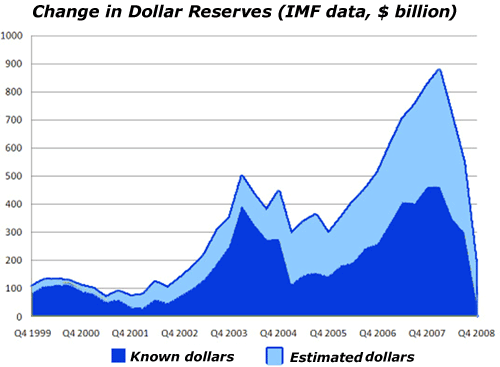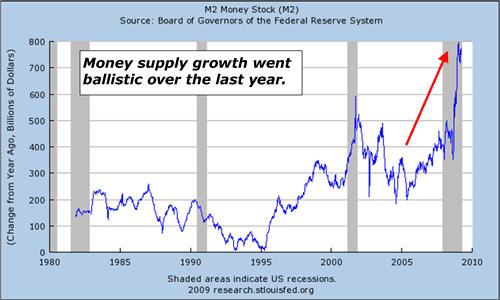U.S. Dollar Doomed as Global Demand for Dollars Slows
Currencies / US Dollar Apr 15, 2009 - 05:31 PM GMT Happy Tax Day! As you fork over money to the IRS, you might want to take a closer look at the U.S. dollar. It could very well be turning into a ticking time bomb inside your wallet.
Happy Tax Day! As you fork over money to the IRS, you might want to take a closer look at the U.S. dollar. It could very well be turning into a ticking time bomb inside your wallet.
To be sure, the dollar’s strength has surprised a lot of people, including me. And it’s tough to bet against the greenback when other currencies are looking even worse. Now, however, the dollar may be coming up against some simple but brutal math — foreign central banks may not be able to finance much of the 2009 U.S. fiscal deficit.
The U.S. needs to borrow $3.25 trillion this fiscal year, according to Goldman Sachs. President Obama is asking Congress to approve a whopping $3.55 trillion budget for 2010, and that may not be enough — the nonpartisan Congressional Budget Office estimated the deficit at $1.38 trillion, higher than the White House’s $1.17 trillion projection.
 |
| The U.S. needs to borrow $3.25 trillion this fiscal year. And if foreign central banks cut back on buying Treasuries, the mighty greenback could be in for a humbling plunge. |
So, if foreign central banks stop or even slow down their purchases of U.S. Treasuries, the mighty greenback could be in for a humbling plunge.
And here’s where the worrying starts:
- China is the top holder of U.S. Treasury bonds with approximately $739.6 billion as of January.
- The Chinese government actually sold bonds heavily in January and February before resuming purchases in March, according to data released over the weekend by China’s central bank.
The Federal Reserve is clearly worried about the ability of foreign central banks to keep buying America’s debt. So now, the Fed is buying U.S. Treasury securities and completed its eighth purchase on Monday. As far as I’m concerned, a government buying its own bonds is like a snake eating its own tail.
Three Reasons These Dollar Worries Continue to Mount …
#1) Global demand for dollars is slowing. Brad Setzer at the Council on Foreign Relations analyzed the Fed’s custodial data. He says central banks are still buying Treasuries but at a slower pace than in late 2008. And the demand isn’t keeping up with issuance. What’s more, the dollar’s share of reserves for reporting emerging economies, which does not include China, fell from 61.3 percent to 59.7 percent last year.
The year-over-year change is quite striking, as you can see on this graph …

In the fourth quarter, the International Monetary Fund (IMF) found that the dollar holdings of countries that report data to the IMF fell by $110 billion. These emerging economies had to sell dollar reserves as investors fled their markets. The reserves of the countries that don’t report data to the IMF fell by $55 billion, and they likely reduced their dollar holdings proportionately.
This could mean hard times ahead for the U.S., because along with the ordinary budget deficit, we are issuing a LOT more debt to pay for various stimulus packages and to bail out the banks. And over time, central bank demand for Treasuries tends to track reserve growth.
#2) The world wants a new reserve currency. The U.S. dollar is the reserve currency for the world. In fact, roughly 65 percent of the world’s foreign exchange reserves were in U.S. dollars at the end of 2008. China and Russia have expressed a desire for a new global reserve currency based on a mix of currencies and gold, and in the form of IMF special drawing rights (SDRs). Zhou Xiaochuan, the governor of China’s central bank, is calling the new currency a “super-sovereign reserve currency.”
Such a process would take years. But even the first steps down the road toward that goal would start to cut away at support for the dollar.
#3) The money supply is exploding. The “broadest” measure of the quantity of money sloshing around the economy measured by the Fed is known as M2. This is all the currency in circulation, plus deposits the banks have on account at the Fed, money market funds and CDs, etc. In other words, it’s the measure of money that will rise along with inflation.
And the M2 is exploding …

So what’s driving the U.S. dollar higher now? Basically, short positions against the U.S. dollar continue to unwind. And while the dollar isn’t winning any beauty contests, the sad-sack economies of Europe make the euro the dollar’s “uglier sister.”
When those short positions are unwound, unless there is a coordinated devaluation in key currencies, and unless the U.S. economy starts to show real improvement, the U.S. dollar index will probably test support and fail.
Two Ways to Play the Trouble Coming for the Dollar and Treasuries
There are a number of ways you could play the next leg down for the U.S. dollar and Treasuries. And here are two of my favorite exchange traded funds (ETFs) you might consider …
ProShares DB US Dollar Index Bearish Fund (UDN). This fund replicates being short the U.S. dollar against a basket of currencies including the euro, Japanese yen, British pound, Canadian dollar, Swedish Krona and Swiss Franc.
ProShares UltraShort 20+ Year Treasury Fund (TBT). This ETF aims to track twice the inverse of the daily performance of the 20-year Treasury bond. So for example, if the Treasury bond drops 10 percent, the TBT could go up 20 percent.
Just remember that leveraged ETFs, like the TBT, can move very quickly. You’d be foolish to play these without protective stops, and check with your investment advisor first.
All the best,
Sean
IMPORTANT NOTE: At the end of this month, I’ll be saying “goodbye” to Money and Markets, and writing only for UncommonWisdomDaily.com, where our focus will be natural resources and international investment opportunities. I have a new video there every Tuesday and a new column every Friday. Be sure to check us out. Writing for Money and Markets has been an honor and a privilege. I hope you’ll sign up for my weekly column at UncommonWisdomDaily.com.
This investment news is brought to you by Money and Markets . Money and Markets is a free daily investment newsletter from Martin D. Weiss and Weiss Research analysts offering the latest investing news and financial insights for the stock market, including tips and advice on investing in gold, energy and oil. Dr. Weiss is a leader in the fields of investing, interest rates, financial safety and economic forecasting. To view archives or subscribe, visit http://www.moneyandmarkets.com .
Money and Markets Archive |
© 2005-2022 http://www.MarketOracle.co.uk - The Market Oracle is a FREE Daily Financial Markets Analysis & Forecasting online publication.



